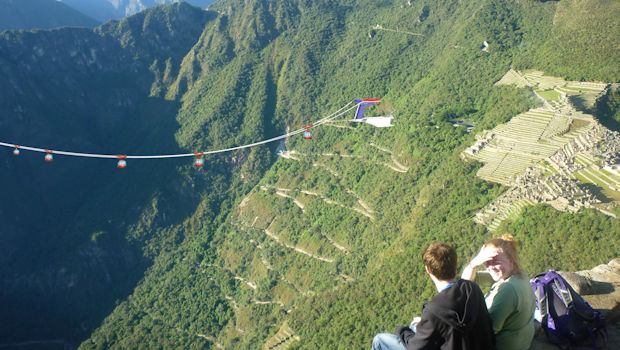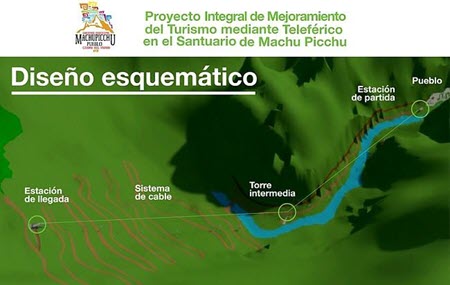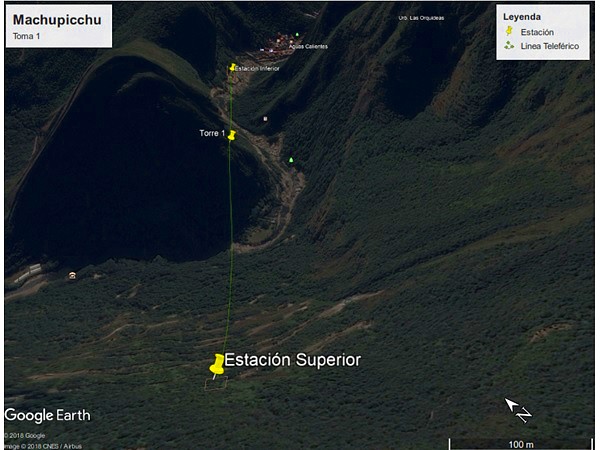
By Rick Vecchio ✐
Peruvian Times Contributing Editor*☄
The United Nations Educational, Scientific and Cultural Organization issued a report 18 years ago warning that a planned aerial cable car system seriously threatened the authenticity and integrity of Machu Picchu. So the project was definitively shelved — or so most people believed.
Peru’s Ministry of Culture is trying to put the kibosh on a local push to resuscitate the cable cars.
The Municipality of Machu Picchu Pueblo, or Aguas Calientes, held workshops last week touting “the characteristics of the project” and the tourism and economic development it would generate “in favor of the inhabitants of the district.”
Three days later, the Ministry of Culture issued a widely reported statement, saying a cable car project was already rejected by UNESCO and is not contemplated in the approved 2015-2019 Master Plan for the Inca sanctuary.
The Ministry of Culture statement went on to say that it has always “been in solidarity with the social demands” of the inhabitants of the district, and as such, “we will seek alternative solutions for the conservation of the site” in accordance with the agreements between the Peruvian State and UNESCO.
But despite the Ministry of Culture’s opposition, Machu Picchu Pueblo Mayor David Gayoso insists the $68 million project will be put out for bid in November and be up and running in time for Peru’s Bicentennial celebration in July 2021.
“There will surely be resistance,” Gayoso told Portal de Turismo, the Web trade publication of Peru’s National Chamber of Tourism.
“Unfortunately, things are not being handled in the country with a sense of social responsibility,” Gayoso said. “We believe that there are other interests that want to take over this type of project, through lobbies and behind our population’s back.”
So, here is the background.
 The days of buses shuttling visitors up and down the switchback Hiram Bingham “highway” are numbered.
The days of buses shuttling visitors up and down the switchback Hiram Bingham “highway” are numbered.
After a series of landslides, studies commissioned by Peru’s National Service of Protected Natural Areas (Sernanp) and the bus concessionaire Consettur, itself, concluded the road, built in 1948, is near the point of permanent collapse.
Under the Master Plan, international bidding for feasibility studies to determine alternative forms of transport from the valley floor up to Machu Picchu are underway.
In the late 1990s, construction of a cable car was approved and set to begin. But it was abruptly canceled after an international uproar over the disturbing visual impact aerial cable cars would create.
UNESCO weighed in on the issue, also pointing out that Peru had not prepared the site for the exponential increase in tourists that a cable car system would deliver.
At the time, Consettur Machupicchu S.A.C. — comprised of nine local transport companies, including the municipal run Tramusa — had recently won the monopolistic concession to shuttle tourists to Machu Picchu. Not surprisingly, the company was dead set against a cable car system cutting into its business.
But times have changed. With the Hiram Bingham highway ready for decommission, the local transport companies want to make sure they’re not left out of the picture.
In a series of exclusive reports, Portal de Turismo has revealed details of the project that Machu Picchu Pueblo’s mayor insists will be built, whether the central government and UNESCO like it or not.
The municipality hired the Lima-based firm Carrizales Infraestructura y Servicios Públicos to draw up the plans. The cable car’s lower station would be built on the outskirts of Aguas Calientes and run 1,820 meters, or just over a mile, past an intermediate support tower and across the gorge to an arrival station at the entrance of Machu Picchu.

The ride would take under 7 minutes and the cable cars would be designed to mobilize a maximum of 3,500 passengers per hour, “thus covering the existing demand in the short, medium and long term.”
Absent a Klingon cloaking device, the cable cars described in this plan would be a major feature of Machu Picchu’s surrounding landscape, especially from the iconic vantage point of Huayna Picchu.
The Ministry of Culture, UNESCO and the multisectoral stakeholders in Cusco are looking at an elevator or monorail, or a combination of both, that could be built beyond the horseshoe bend of the Vilcanota River, out of sight from the citadel above.
That system would track up the mountainside, camouflaged by the dense vegetation.
As mentioned, one of the principal companies in the Consettur bus consortium is Tramusa, which belongs to the District Municipality of Machu Picchu.
Portal de Turismo reported that under the municipality’s plan, it will have direct participation in the new transportation system, in effect granting itself a 30 concession.
The total project investment would be $68 million, with 70 percent financed for 12 years and 30 percent raised from direct capital investment. Annual operating costs are projected at $15 million, including estimated average royalties of $4.7 million a year minimum, pegged to revenues that are projected to increase with demand. The annual profitability of the operation is projected at $15 million.
That cable car concessionaire would have a 10 percent stake in the project, but would be obligated to execute a public offering of shares to residents of Machu Picchu Pueblo, as well as legal owners of businesses in the town, for up to 90 percent of the project’s capital.
That would purportedly give the population of Machu Picchu Pueblo the largest overall stake as minority shareholders. “The social capital of the company will be equivalent to 30 percent of the total investment of the project,” the project prospectus reportedly states.
So where does all this leave the other bus companies that comprise Consettur?
Apparently, in the catbird seat.
According to Portal de Turismo, the document states: “The transport companies will provide the service as they are currently during the construction period (of the cable car system). They will also remain as a cold reserve for a specific time and may participate as bidders or shareholders in this project.”
Consettur has been under fire for years for the questionable circumstances under which it claimed its last 30-year concession, granted in August 1995 after then-President Alberto Fujimori fast-tracked the privatization of tourism concessions and removed oversight and controls to help re-ignite Peru’s economy.
Stay tuned.
_______________________________
✐ Rick Vecchio is also director of marketing and development for Fertur Peru Travel, which is owned by his wife, Siduith Ferrer, and is a commercial sponsor of Andean Air Mail & PERUVIAN TIMES. You can read more of his articles on the Peruvian Travel Trends blog.





